WORK/LIVE 干活 Arrow Factory Beijing
BURN 焚
Zhao Haibo 赵海波 / Social Sensibility Research Institute
Intro courtesy of ARROW FACTORY Beijing
Blustery spring winds signal the change of seasons in Beijing. To fortify against the remaining gusts of frigid air, Arrow Factory is pleased to present Burn, a new installation by Zhao Haibo and the Social Sensibility Research Institute (SSRI). Burn features a semi-abstracted photo of glowing embers displayed as an illuminated lightbox, which burns bright and then fades in slow regular cycles. Zhao Haibo’s innovative perspective and intimate treatment of a pile of charred corn cobs is as much an expression of home and hearth as it is an articulation of quiet resilience. Zhao Haibo’s sentiment of perseverance is echoed in the the hutong surroundings where daily life continues behind the onerous grey walls blanketing the city center. Zhao Haibo’s striking photo is framed to resemble a floating planet, or the view from a microscope, the abstraction offering simultaneously both micro and macro possibilities. In conjunction with the window display, anonymous postcards of the image are left in random locations throughout the neighborhood — a re-occurring spark, asserting itself like a small exclamation mark in the hutongs. Zhao Haibo is from a small village in Qiqihar where he grew up working the fields. In 2016 he came to Beijing and found employment at Bernard Controls — a mid-sized actuator factory in the south of Beijing. Bernard Controls not only produces valves, but is also host to the Social Sensibility Research Institute and the LIVE/WORK project, a remarkable initiative run by artists Alessandro Rolandi and Tianji Zhao. SSRI invites artists to spend extended time in, among and with the employees at the Bernard Controls production facility and the company allows creative work to happen on site at their factory. SSRI began in 2010 as an unpaid and unstructured nine-month experiment. Rolandi formally established the initiative with the CEO of Bernard Controls, Guillaume Bernard, in 2011 as an innovative program of worker engagement paired with social art practice. SSRI’s LIVE/WORK project centers on individual conversations about the relationships between work and life, and aims to develop these exchanges into larger ideas incorporating contemporary and modern artists' works. Rolandi and Tianji Zhao accompany employees from the factory from all different levels (worker, manager, etc.) who are interested to create their own artworks. When Zhao Haibo arrived at Bernard Controls, there was little engagement with Rolandi and Tianji Zhao. Their interactions began as short chats during break times. Slowly, it grew into the exchange of art books and naturally blossomed into conversations about the ideas contained therein. Zhao Haibo had an innate sense about the images and concepts contained in the pages, and studied the publications intensely. Rolandi and Tianji Zhao have developed a form of engagement at Bernard Controls that exercises a light touch—never openly directing employees to make artwork, but instead making themselves available as a resource for those who are interested. After eighteen months of casual discussion, Zhao Haibo showed Rolandi and Tianji Zhao an abstract painting that he created on the lid of an industrial paint bucket. Zhao Haibo discussed his interest in the painting process and a desire to affect a materiality by creating protrusions using industrial spray paint. From there, the creative engagement between the three began in earnest and Zhao Haibo expanded his visual experiments to include photography and video using his cell phone. This luxury of extended time in SSRI and the LIVE/WORK project is highly unconventional inside a commercial factory. This ability to have sustained engagement in the workplace affords more organic interactions and the opportunity to forge deeper ties between artists and employees. SSRI’s artistic practice aims to blur categories and definitions—worker/management, worker/artists, home/work, art/life, etc., etc.—to arrive at a condition where the “rules of engagement are invented and negotiated all the time.” SSRI explains, “In a tangible and relational space, this small and humble moment [of physical encounter between artists and people] is very fragile but extremely precious, and it possesses unlimited potentialities.” Arrow Factory’s working method also aims to manifest subtle and ambiguous happenstances. On this fifth collaboration between SSRI and Arrow Factory, there is an acknowledgement that the process for realizing these unique projects is complex and nuanced, an organic layering that builds up over time. For Burn, the installation centers on Zhao Haibo’s photograph, developed through his relationship with Rolandi and Tianji Zhao. Arrow Factory’s subsequent interactions with SSRI evolves these ideas further into an installation for the street-side window display. The multitude of exchanges between Zhao Haibo, SSRI and Arrow Factory all converge together as a single creative gesture. SSRI’s expansive practice moves seamlessly from the artist’s studio to a company’s production line and beyond, escorting the slow smoldering path of Zhao Haibo’s Burn from a farm, to an urban factory, to Arrow Factory.
干活北京箭厂空间
《焚》
赵海波/社会敏感性研究所
狂烈的春风是北京季节变化的信号。为了抵御剩余的冷空气,箭厂空间荣幸地展出赵海波和社会敏感性研究所(SSRI)的新装置《焚》。作品是一张余烬的半抽象照片,通过灯箱缓慢地燃烧及熄灭。赵海波以独特的视角对一堆碳化玉米棒的处理,既是对家和火炉的表达,也呈现了某种沉默的韧性。他坚持不懈的精神与胡同的环境相呼应,在笼罩着市中心沉重的灰墙后面,生活依然在继续。这张引人注目的照片在框架中像一颗漂浮的行星,或是显微镜下的景象——抽象同时提供了微观和宏观的可能性。与橱窗展示结合,图像以匿名明信片的形式散布到街区的各个角落。这个不断显现的火花犹如胡同里的一个小感叹号,坚持着自己的立场。
赵海波来自黑龙江齐齐哈尔的一个小村庄,在田里劳作长大。2016年来到北京,在位于南五环的一家中型执行器工厂(伯纳德控制设备有限公司)工作。伯纳德不仅生产阀门,还运转着一个不寻常的自发项目——由艺术家李山和赵天汲负责的社会敏感性研究所和“干,活”系列。SSRI邀请艺术家与伯纳德员工在工厂的环境中长时间相处,其间公司允许在地创作的发生。 SSRI始于2010年,起初是一个为期九个月,无报酬、非正规的实验。2011年,李山与伯纳德总经理Guillaume Bernard正式成立了这个由公司成员参与的社会艺术实践项目。SSRI的“干,活”系列以私密交谈的方式探讨工作和生活之间的关系,并借助现当代艺术形式呈现交流中生成的想法。李山和赵天汲协助来自工厂各个阶层(工人、经理等),对此项目感兴趣的员工进行艺术创作。
赵海波刚到伯纳德时与李山和赵天汲接触不多,最初在休息时闲聊,逐渐开始交换艺术书籍,并自然而然地展开了有关书中内容的讨论。赵海波阅览刊物时非常专注,他对页面上的图像和观念有先天的洞察力。李山和赵天汲在伯纳德启动了一种轻松的参与模式——从不公然指导员工创作,而是使自己成为易接近的资源。经过十八个月的随机对话,赵海波向李山和赵天汲展示了他在工业油漆桶盖上创作的一幅抽象画,并阐述了自己对绘画过程的兴趣,以及如何用工业喷漆绘制凸点而形成纹理。从那时起,三人之间的创意互动郑重开始,赵海波将他的视觉实验扩展到用手机拍照和视频记录。SSRI和“干,活”系列这种奢侈的长期项目在工业企业中极为另类,在工作场所中持续性的参与促使了更自然的互动,同时让艺术家和员工有机会建立更深的关系。
WORK/LIVE 干活 Arrow Factory Pékin
BURN 焚 (BRÛLER)
Zhao Haibo 赵海波 / Institut de recherche sur la sensibilité sociale
Introduction avec l'autorisation de ARROW FACTORY Beijing
Les vents violents du printemps signalent le changement de saison à Pékin. Pour se protéger des dernières rafales d'air glacial, Arrow Factory a le plaisir de présenter Burn, une nouvelle installation de Zhao Haibo et du Social Sensibility Research Institute (SSRI). Burn présente une photo semi-abstraite de braises incandescentes affichées sous la forme d'une boîte à lumière illuminée, qui brûle vivement puis s'estompe selon des cycles lents et réguliers. La perspective innovante de Zhao Haibo et le traitement intime d'un tas d'épis de maïs carbonisés sont autant une expression de la maison et du foyer qu'une articulation de la résilience tranquille. Le sentiment de persévérance de Zhao Haibo trouve un écho dans les environs du hutong où la vie quotidienne se poursuit derrière les murs gris onéreux qui recouvrent le centre-ville. La photo saisissante de Zhao Haibo est encadrée pour ressembler à une planète flottante, ou à la vue d'un microscope, l'abstraction offrant simultanément des possibilités micro et macro. En conjonction avec la vitrine, des cartes postales anonymes de l'image sont laissées à des endroits aléatoires dans tout le quartier - une étincelle récurrente, s'affirmant comme un petit point d'exclamation dans les hutongs. Zhao Haibo est originaire d'un petit village de Qiqihar où il a grandi en travaillant les champs. En 2016, il est venu à Pékin et a trouvé un emploi chez Bernard Controls, une usine d'actionneurs de taille moyenne dans le sud de Pékin.
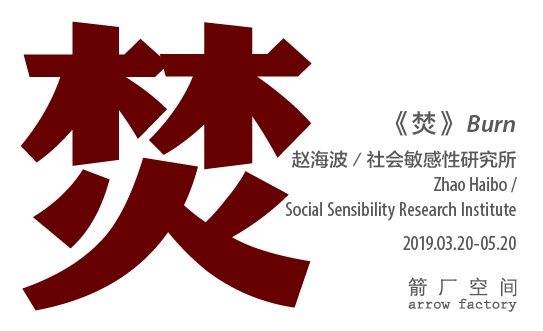
WORK/LIVE 干活 Arrow Factory Beijing
BURN 焚
Zhao Haibo 赵海波 / Social Sensibility Research Institute
Intro courtesy of ARROW FACTORY Beijing
Blustery spring winds signal the change of seasons in Beijing. To fortify against the remaining gusts of frigid air, Arrow Factory is pleased to present Burn, a new installation by Zhao Haibo and the Social Sensibility Research Institute (SSRI). Burn features a semi-abstracted photo of glowing embers displayed as an illuminated lightbox, which burns bright and then fades in slow regular cycles. Zhao Haibo’s innovative perspective and intimate treatment of a pile of charred corn cobs is as much an expression of home and hearth as it is an articulation of quiet resilience. Zhao Haibo’s sentiment of perseverance is echoed in the the hutong surroundings where daily life continues behind the onerous grey walls blanketing the city center. Zhao Haibo’s striking photo is framed to resemble a floating planet, or the view from a microscope, the abstraction offering simultaneously both micro and macro possibilities. In conjunction with the window display, anonymous postcards of the image are left in random locations throughout the neighborhood — a re-occurring spark, asserting itself like a small exclamation mark in the hutongs. Zhao Haibo is from a small village in Qiqihar where he grew up working the fields. In 2016 he came to Beijing and found employment at Bernard Controls — a mid-sized actuator factory in the south of Beijing. Bernard Controls not only produces valves, but is also host to the Social Sensibility Research Institute and the LIVE/WORK project, a remarkable initiative run by artists Alessandro Rolandi and Tianji Zhao. SSRI invites artists to spend extended time in, among and with the employees at the Bernard Controls production facility and the company allows creative work to happen on site at their factory. SSRI began in 2010 as an unpaid and unstructured nine-month experiment. Rolandi formally established the initiative with the CEO of Bernard Controls, Guillaume Bernard, in 2011 as an innovative program of worker engagement paired with social art practice. SSRI’s LIVE/WORK project centers on individual conversations about the relationships between work and life, and aims to develop these exchanges into larger ideas incorporating contemporary and modern artists' works. Rolandi and Tianji Zhao accompany employees from the factory from all different levels (worker, manager, etc.) who are interested to create their own artworks. When Zhao Haibo arrived at Bernard Controls, there was little engagement with Rolandi and Tianji Zhao. Their interactions began as short chats during break times. Slowly, it grew into the exchange of art books and naturally blossomed into conversations about the ideas contained therein. Zhao Haibo had an innate sense about the images and concepts contained in the pages, and studied the publications intensely. Rolandi and Tianji Zhao have developed a form of engagement at Bernard Controls that exercises a light touch—never openly directing employees to make artwork, but instead making themselves available as a resource for those who are interested. After eighteen months of casual discussion, Zhao Haibo showed Rolandi and Tianji Zhao an abstract painting that he created on the lid of an industrial paint bucket. Zhao Haibo discussed his interest in the painting process and a desire to affect a materiality by creating protrusions using industrial spray paint. From there, the creative engagement between the three began in earnest and Zhao Haibo expanded his visual experiments to include photography and video using his cell phone. This luxury of extended time in SSRI and the LIVE/WORK project is highly unconventional inside a commercial factory. This ability to have sustained engagement in the workplace affords more organic interactions and the opportunity to forge deeper ties between artists and employees. SSRI’s artistic practice aims to blur categories and definitions—worker/management, worker/artists, home/work, art/life, etc., etc.—to arrive at a condition where the “rules of engagement are invented and negotiated all the time.” SSRI explains, “In a tangible and relational space, this small and humble moment [of physical encounter between artists and people] is very fragile but extremely precious, and it possesses unlimited potentialities.” Arrow Factory’s working method also aims to manifest subtle and ambiguous happenstances. On this fifth collaboration between SSRI and Arrow Factory, there is an acknowledgement that the process for realizing these unique projects is complex and nuanced, an organic layering that builds up over time. For Burn, the installation centers on Zhao Haibo’s photograph, developed through his relationship with Rolandi and Tianji Zhao. Arrow Factory’s subsequent interactions with SSRI evolves these ideas further into an installation for the street-side window display. The multitude of exchanges between Zhao Haibo, SSRI and Arrow Factory all converge together as a single creative gesture. SSRI’s expansive practice moves seamlessly from the artist’s studio to a company’s production line and beyond, escorting the slow smoldering path of Zhao Haibo’s Burn from a farm, to an urban factory, to Arrow Factory.
干活北京箭厂空间
《焚》
赵海波/社会敏感性研究所
狂烈的春风是北京季节变化的信号。为了抵御剩余的冷空气,箭厂空间荣幸地展出赵海波和社会敏感性研究所(SSRI)的新装置《焚》。作品是一张余烬的半抽象照片,通过灯箱缓慢地燃烧及熄灭。赵海波以独特的视角对一堆碳化玉米棒的处理,既是对家和火炉的表达,也呈现了某种沉默的韧性。他坚持不懈的精神与胡同的环境相呼应,在笼罩着市中心沉重的灰墙后面,生活依然在继续。这张引人注目的照片在框架中像一颗漂浮的行星,或是显微镜下的景象——抽象同时提供了微观和宏观的可能性。与橱窗展示结合,图像以匿名明信片的形式散布到街区的各个角落。这个不断显现的火花犹如胡同里的一个小感叹号,坚持着自己的立场。
赵海波来自黑龙江齐齐哈尔的一个小村庄,在田里劳作长大。2016年来到北京,在位于南五环的一家中型执行器工厂(伯纳德控制设备有限公司)工作。伯纳德不仅生产阀门,还运转着一个不寻常的自发项目——由艺术家李山和赵天汲负责的社会敏感性研究所和“干,活”系列。SSRI邀请艺术家与伯纳德员工在工厂的环境中长时间相处,其间公司允许在地创作的发生。 SSRI始于2010年,起初是一个为期九个月,无报酬、非正规的实验。2011年,李山与伯纳德总经理Guillaume Bernard正式成立了这个由公司成员参与的社会艺术实践项目。SSRI的“干,活”系列以私密交谈的方式探讨工作和生活之间的关系,并借助现当代艺术形式呈现交流中生成的想法。李山和赵天汲协助来自工厂各个阶层(工人、经理等),对此项目感兴趣的员工进行艺术创作。
赵海波刚到伯纳德时与李山和赵天汲接触不多,最初在休息时闲聊,逐渐开始交换艺术书籍,并自然而然地展开了有关书中内容的讨论。赵海波阅览刊物时非常专注,他对页面上的图像和观念有先天的洞察力。李山和赵天汲在伯纳德启动了一种轻松的参与模式——从不公然指导员工创作,而是使自己成为易接近的资源。经过十八个月的随机对话,赵海波向李山和赵天汲展示了他在工业油漆桶盖上创作的一幅抽象画,并阐述了自己对绘画过程的兴趣,以及如何用工业喷漆绘制凸点而形成纹理。从那时起,三人之间的创意互动郑重开始,赵海波将他的视觉实验扩展到用手机拍照和视频记录。SSRI和“干,活”系列这种奢侈的长期项目在工业企业中极为另类,在工作场所中持续性的参与促使了更自然的互动,同时让艺术家和员工有机会建立更深的关系。
WORK/LIVE 干活 Arrow Factory Pékin
BURN 焚 (BRÛLER)
Zhao Haibo 赵海波 / Institut de recherche sur la sensibilité sociale
Introduction avec l'autorisation de ARROW FACTORY Beijing
Les vents violents du printemps signalent le changement de saison à Pékin. Pour se protéger des dernières rafales d'air glacial, Arrow Factory a le plaisir de présenter Burn, une nouvelle installation de Zhao Haibo et du Social Sensibility Research Institute (SSRI). Burn présente une photo semi-abstraite de braises incandescentes affichées sous la forme d'une boîte à lumière illuminée, qui brûle vivement puis s'estompe selon des cycles lents et réguliers. La perspective innovante de Zhao Haibo et le traitement intime d'un tas d'épis de maïs carbonisés sont autant une expression de la maison et du foyer qu'une articulation de la résilience tranquille. Le sentiment de persévérance de Zhao Haibo trouve un écho dans les environs du hutong où la vie quotidienne se poursuit derrière les murs gris onéreux qui recouvrent le centre-ville. La photo saisissante de Zhao Haibo est encadrée pour ressembler à une planète flottante, ou à la vue d'un microscope, l'abstraction offrant simultanément des possibilités micro et macro. En conjonction avec la vitrine, des cartes postales anonymes de l'image sont laissées à des endroits aléatoires dans tout le quartier - une étincelle récurrente, s'affirmant comme un petit point d'exclamation dans les hutongs. Zhao Haibo est originaire d'un petit village de Qiqihar où il a grandi en travaillant les champs. En 2016, il est venu à Pékin et a trouvé un emploi chez Bernard Controls, une usine d'actionneurs de taille moyenne dans le sud de Pékin.
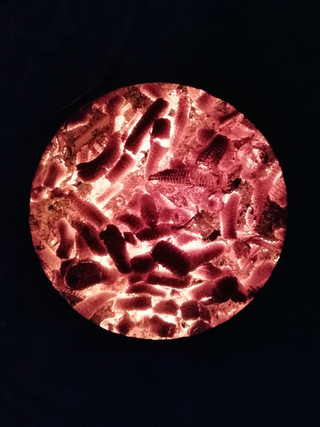
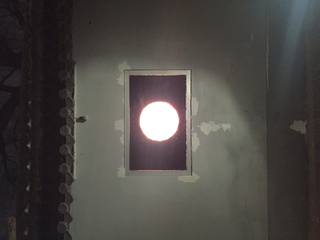
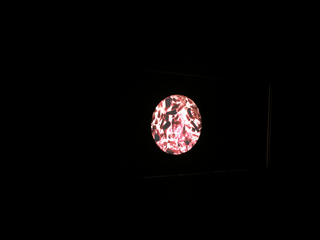
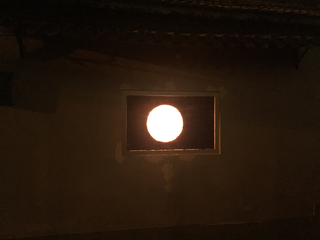
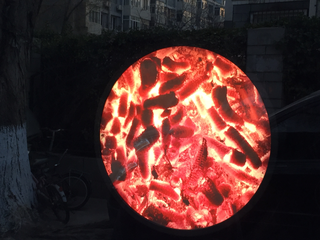
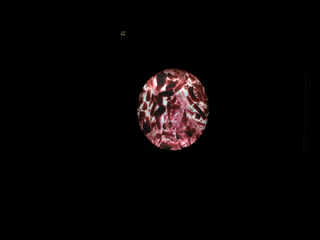
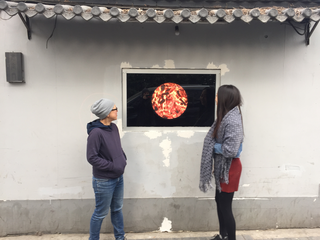
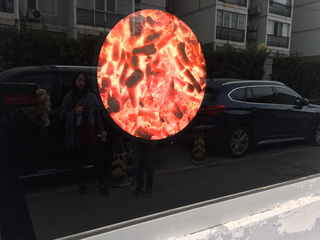
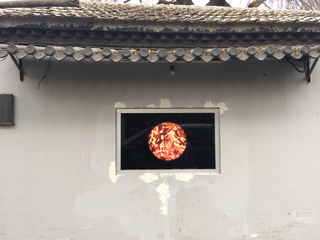
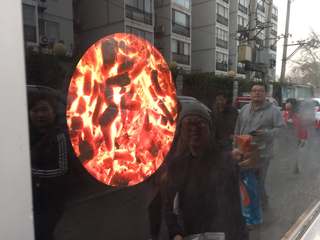
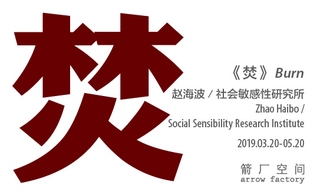
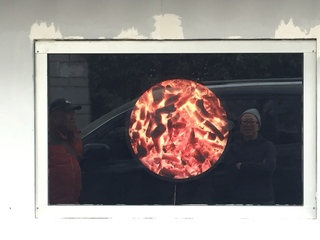
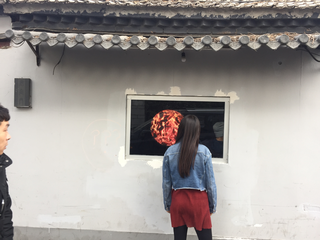
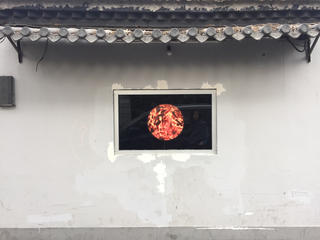
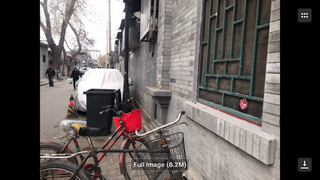
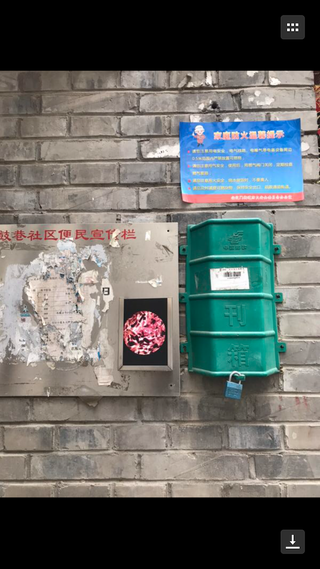
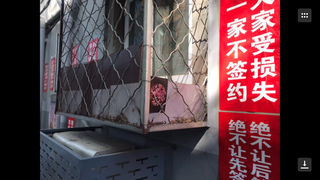
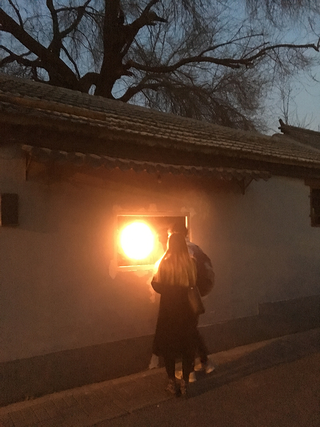
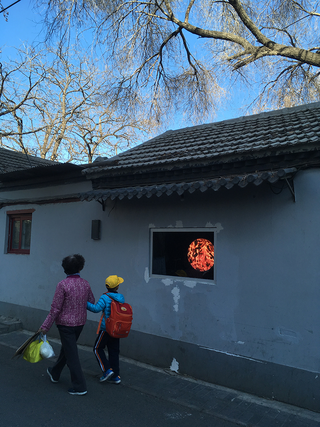
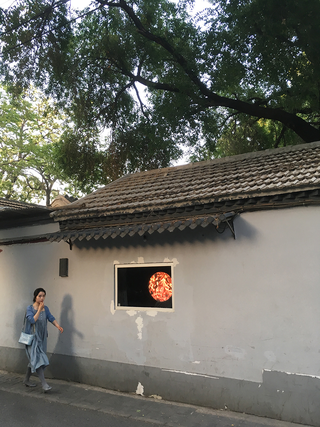
Social
Contatti
socialsensibilityrd@gmail.com